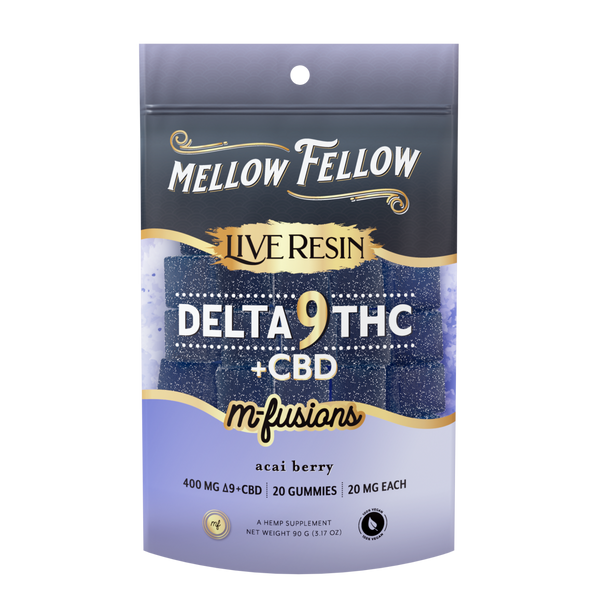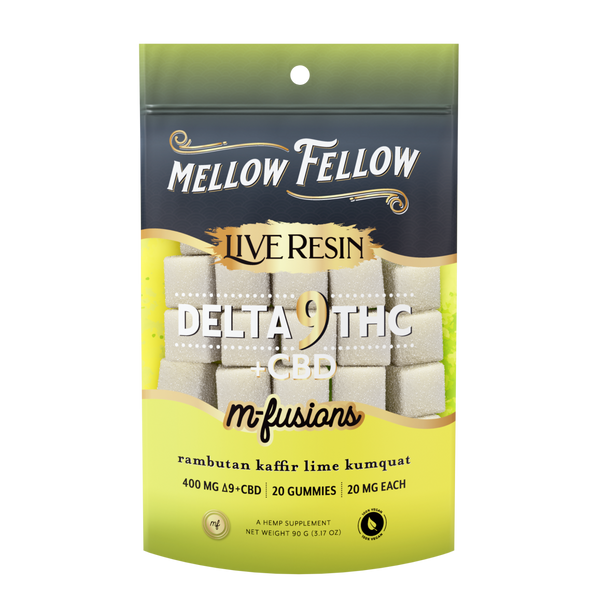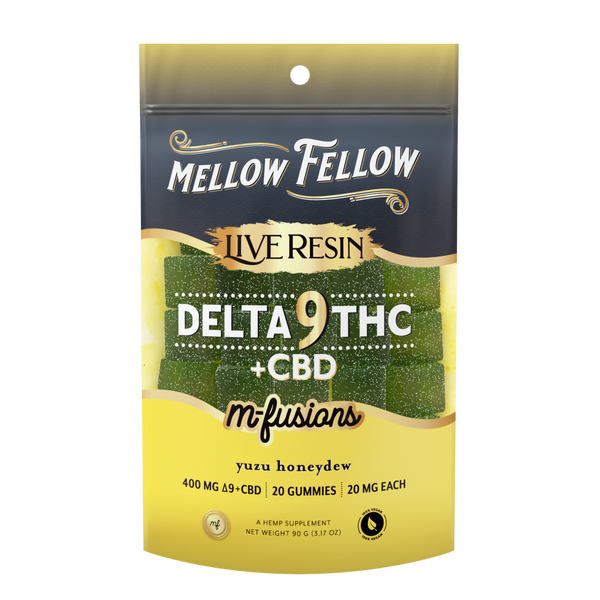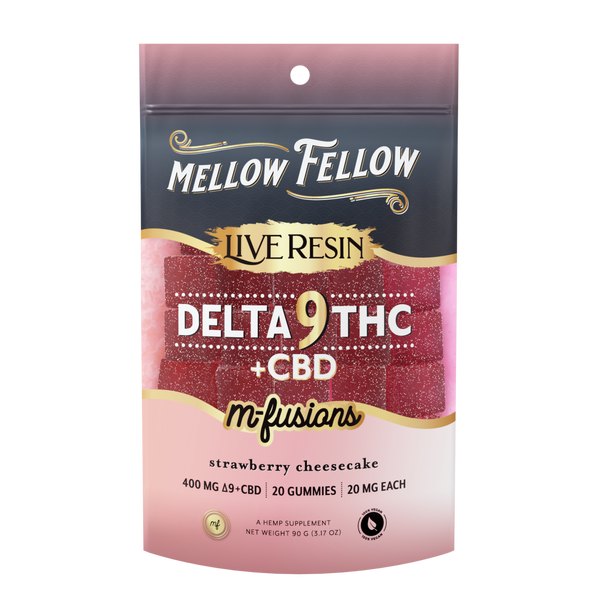Delta 9 vs. Delta 10: Which Cannabinoid Fits Your Vibe?

Are you curious about Delta 9 vs. Delta 10 and which one actually suits you better? These two cannabinoids may look similar on a label, but they feel completely different once you try them.
Delta 9 delivers the familiar, full-bodied experience most people expect from cannabis, while Delta 10 is known for being lighter, more clear-headed, and often better for daytime use.
The problem is that most explanations barely scratch the surface. This guide lays out the real differences in potency, effects, and legality so you can choose with confidence.
Key Takeaways
-
Delta 9 THC is the most studied cannabinoid, delivering stronger psychoactive effects and deeper physical relief.
-
Delta 10 THC is milder and more stimulating, making it popular for daytime activities and creative tasks.
-
Delta 9 occurs naturally in higher concentrations, while Delta 10 is produced through the isomerization of hemp-derived CBD.
-
Hemp-derived Delta 9 and Delta 10 are federally legal if under 0.3% Delta 9 THC, but some states restrict these cannabinoids.
-
Delta 9 products are often used for appetite stimulation, nausea control, and evening relaxation.
-
Delta 10 products are better suited for users seeking a light mood boost and mental clarity without heavy sedation.
-
Try Mellow Fellow’s premium blends and bundles to experience both cannabinoids and find the effects that fit your lifestyle.
What Is Delta 9 THC?
Delta 9 THC is the primary psychoactive compound found in cannabis and is responsible for the traditional high most people associate with marijuana. Its name comes from the placement of a double bond on the ninth carbon atom in its molecular chain.
This structure allows Delta 9 to bind strongly to CB1 receptors in the brain and central nervous system, producing pronounced psychoactive effects.
Historical Context and Discovery
Delta 9 THC was first isolated in 1964 by Dr. Raphael Mechoulam and his team at Hebrew University in Jerusalem. Their work laid the foundation for modern cannabis research and is still widely referenced today.
Since then, Delta 9 has remained the most extensively studied cannabinoid, with research covering everything from its psychoactive properties to its potential therapeutic uses.
Natural Occurrence and Legal Thresholds
Delta 9 occurs naturally in cannabis plants, often appearing in concentrations of 15% to 25% in modern high-potency marijuana strains. Hemp plants, on the other hand, must legally contain less than 0.3% Delta 9 THC on a dry weight basis to comply with U.S. federal regulations.
This distinction is crucial because it separates marijuana products from hemp-derived options that are legal in many states.
How the Body Processes Delta 9
Your body absorbs Delta 9 differently depending on how you consume it. When inhaled through smoking or vaping, Delta 9 enters the bloodstream directly through the lungs and typically peaks within three to ten minutes.
When taken orally in edibles or capsules, such as our Delta 9 Live Resin Strawberry Rings, the compound undergoes first-pass metabolism in the liver. This process converts Delta 9 into 11-hydroxy-THC, a metabolite that is potentially two to seven times more potent, which explains why edibles often feel stronger and last longer than inhaled products.
What Is Delta 10 THC?
Delta 10 THC is another naturally occurring cannabinoid that shares the same molecular formula as Delta 9, but differs in the placement of its double bond.
In Delta 10, the double bond is located on the tenth carbon atom rather than the ninth. While this structural shift may seem subtle, it alters how the compound interacts with cannabinoid receptors in your body.
Delta 10 binds more weakly to CB1 receptors, which contributes to its milder psychoactive effects.
Discovery and Origin
The discovery of Delta 10 occurred in 2020 under unusual circumstances. Fusion Farms, a cannabis company in California, noticed unexpected crystalline formations while processing cannabis distillate.
Later investigation revealed that wildfire retardant chemicals had unintentionally catalyzed the formation of this new THC isomer. Once isolated and studied, Delta 10 quickly drew attention for its distinctive effects and potential applications.
Natural Occurrence and Production
Unlike Delta 9, which occurs abundantly in most cannabis strains, Delta 10 appears only in trace quantities. Because of this scarcity, most commercial Delta 10 products are synthesized through a process called isomerization.
In this method, CBD derived from legal hemp is chemically rearranged using food-grade acids and carefully controlled heat to produce Delta 10. This approach allows manufacturers to create consistent, scalable products despite Delta 10’s rarity in nature.
Purity and Quality Testing
Modern Delta 10 products, such as disposable vapes and gummies, undergo rigorous third-party lab testing to confirm potency, purity, and the absence of residual solvents or unwanted byproducts.
For example, our AK-47 Delta 10 Disposable is tested to ensure that the conversion from CBD to Delta 10 is complete and that no harmful contaminants remain. This testing is essential, as improper synthesis can lead to impurities that affect both safety and flavour.
Effects and Potency Comparison
The way Delta 9 and Delta 10 interact with cannabinoid receptors directly influences how each compound feels in the body and mind.
Studies, including research from the British Journal of Pharmacology, confirm that binding affinity to CB1 receptors strongly correlates with the intensity of psychoactive effects.
Delta 9 binds tightly, creating a stronger high, while Delta 10’s weaker binding results in a milder and more functional experience.
Delta 9 Effects
Delta 9’s strong CB1 activation produces the classic cannabis high most people are familiar with. Users commonly describe feelings of deep euphoria, relaxation, and heightened sensory perception.
Colors may appear richer, music often sounds more immersive, and food can taste exceptionally satisfying.
At higher doses, Delta 9 frequently leads to heavy physical relaxation, sometimes referred to as couch-lock. It can also noticeably alter time perception, with short periods feeling much longer during peak effects.
To experience these effects for yourself, try our Delta 9 Live Resin Blue Razz Rings.
Delta 10 Effects
Delta 10 provides a distinctly different experience. Rather than producing heavy sedation, it is often described as a “functional high” that stays primarily in the head.
Many users report increased energy, mental clarity, and improved focus, making it popular for daytime use or creative tasks.
The body effects are light and stimulating rather than deeply relaxing, often compared to the boost from a strong cup of coffee paired with mild cannabis effects. This makes Delta 10 appealing to those who want a smoother experience without feeling weighed down.
Our Creativity Blend Shipwreck Live Resin Disposable Vape is a great place to start.
Potency Comparison
Delta 9 is significantly more potent than Delta 10. The stronger binding to CB1 receptors means lower doses of Delta 9 produce more pronounced psychoactive effects, while Delta 10 generally requires higher amounts to achieve a similar impact.
For consumers, this difference affects not only the high but also the ideal situations for use - Delta 9 tends to suit evenings or laid-back settings, while Delta 10 works well when you still need to stay active and engaged.
| Aspect | Delta 9 THC | Delta 10 THC |
| Standard Dose | 5-10mg | 25-50mg |
| Onset (Inhaled) | 2-10 minutes | 5-15 minutes |
| Peak Effects | 30-60 minutes | 45-90 minutes |
| Duration | 2-4 hours | 1.5-3 hours |
| Intensity Rating | 8-10/10 | 4-6/10 |
If you’d like to try a Delta 10 blend designed to spark your creativity, try our Creativity Blend White Widow Disposable Vape.
Legal Status and Availability
The legality of Delta 9 and Delta 10 THC varies widely across the United States, creating a patchwork of regulations that can be confusing for consumers. Both compounds are affected by federal and state laws, but their origins - marijuana versus hemp - play a major role in how they are classified.
Delta 9 THC Regulations
Delta 9 THC remains a Schedule I controlled substance under federal law, meaning marijuana-derived products with significant Delta 9 content are illegal at the federal level.
Yet, state laws tell a different story.
As of 2025, 38 states have legalized medical marijuana programs, and 24 of those states also permit adult-use recreational cannabis. This state-level legalization allows dispensaries to sell high-THC cannabis products openly where permitted.
The 2018 Farm Bill created a notable exception for hemp-derived Delta 9 THC. Products containing less than 0.3% Delta 9 THC on a dry weight basis are federally legal, even if they deliver a measurable psychoactive dose.
For example, a 10‑gram gummy can legally contain up to 30 milligrams of Delta 9 THC while still meeting the federal limit. This loophole explains why hemp-derived Delta 9 edibles are widely available in states that still prohibit recreational marijuana.
Delta 10 THC Regulations
Delta 10 THC falls into a similar legal category when derived from hemp. The Farm Bill’s definition of hemp includes “all derivatives, extracts, cannabinoids, and isomers” with less than 0.3% Delta 9 THC, which indirectly allows Delta 10 products to be sold federally. This has led to a surge of hemp-derived Delta 10 vapes and edibles on the market.
That said, several states have taken steps to restrict or ban THC isomers like Delta 10, citing concerns about unregulated production and safety.
As of 2025, approximately 14 states have implemented restrictions or outright prohibitions on Delta 10 products. Because these laws evolve quickly, it is essential to verify local regulations before purchasing or traveling with Delta 10 THC.
Availability for Consumers
Both Delta 9 and Delta 10 products are widely available online and in physical shops, though the type of product you find depends on the state.
Hemp-derived versions are more commonly sold nationwide, while marijuana-derived Delta 9 products are limited to dispensaries in legalized states - check out Mellow Fellow for both.
Consumers should always review lab reports to confirm THC levels and ensure compliance with both federal and state laws.
Production Methods Matter
How Delta 9 and Delta 10 THC are produced plays a direct role in their purity, safety, and overall effects. Being familiar with the production process helps you identify quality products and avoid poorly made options.
Delta 9 Production
Delta 9 THC is typically extracted directly from cannabis or hemp flower. Two of the most common methods are CO2 extraction and ethanol extraction. Supercritical CO2 extraction uses high pressure and moderate temperatures to separate cannabinoids and terpenes without degrading them.
The crude extract produced through this method then undergoes winterization to remove plant waxes and fats, followed by distillation to reach purity levels exceeding 90%.
Another route to Delta 9 involves THCa concentrates, such as our ever-popular THCa Budder that’s perfect for dabbing, vaping, and making edibles with. THCa is the acidic precursor to Delta 9 THC and becomes psychoactive only after decarboxylation, which occurs when heat is applied.
THCa concentrates remain federally hemp-compliant because they contain less than 0.3% Delta 9 THC before activation. Once heated during vaping or dabbing, THCa converts into active Delta 9, producing effects similar to traditional cannabis.
Delta 10 Production
Delta 10 THC does not naturally occur in significant amounts in cannabis, so producers typically create it through isomerization.
This process begins with CBD isolate derived from hemp, which is then chemically rearranged into Delta 10 using food-grade acids under controlled heat. The process requires careful monitoring of temperature, pH, and reaction time to ensure proper conversion.
Related Products
Importance of Quality Control
The quality of Delta 10 products varies widely between manufacturers. Poorly controlled conversions can leave behind unwanted isomers like Delta 8 or residual solvents.
Reputable brands provide third-party lab results confirming both purity and cannabinoid content. When reviewing certificates of analysis, look for Delta 10 as the dominant cannabinoid and confirm that other THC isomers are present only in trace amounts.
Medical Benefits and Research
Delta 9 THC and Delta 10 THC share a similar chemical backbone, yet their therapeutic potential differs significantly. Delta 9 has decades of clinical research behind it, while Delta 10 remains largely supported by early findings and anecdotal reports.

Both cannabinoids show promise for improving comfort, mood, and overall quality of life, but they do so in different ways.
Delta 9 THC
Delta 9 THC is the most extensively researched form of THC and has a long history of medical use across multiple conditions. Its ability to bind strongly to CB1 receptors explains both its psychoactive effects and its therapeutic value.
Appetite Stimulation and Nausea Relief
The StatPearls review by Ng and Keshock highlights that Delta 9’s synthetic analogs - dronabinol and nabilone - are FDA-approved for managing chemotherapy-related nausea and for stimulating appetite in severe weight loss conditions. This demonstrates Delta 9’s ability to modulate both digestive discomfort and appetite regulation effectively.
If you’re looking for something that can do the opposite of appetite stimulation, while also providing an energy boost, try Mellow Fellow’s Charged Blend Wedding Crasher Disposable - loaded with THCv, CBD, CBG, and more.
Pain Management and Quality of Life
A multicenter survey published in Anesthesiology Research and Practice assessed Delta 9 use in patients with chronic central neuropathic pain.
Over the course of seven months, participants reported measurable reductions in pain intensity and disability scores, along with improved overall quality of life.
Notably, many patients also reduced their reliance on opioid medications, suggesting Delta 9 works well as a coanalgesic rather than a sole treatment.
Mood and Relaxation Effects
Beyond physical relief, Delta 9 contributes to mood elevation and reduced stress. The Mental Health Clinician review notes its effects on both CB1 and CB2 receptors, which can lead to improvements in sleep patterns, muscle relaxation, and overall emotional balance.
To get a good night’s sleep, try our Dream Blend Live Resin Green Apple Edibles.
Delta 10 THC
Delta 10 THC is far newer to both the market and scientific research, but its milder psychoactive profile and energizing qualities have already drawn attention from consumers looking for functional daytime support.
Cognitive and Creative Benefits
Research summarized by Recovered.org indicates that Delta 10 often produces an uplifting, clear-headed high. Users frequently report increased creativity and improved focus, making it suitable for tasks requiring alertness rather than sedation.
Neurochemical Activity and Energy Levels
Preclinical findings suggest that Delta 10 may raise dopamine and norepinephrine levels without the heavy sedative effects seen with Delta 9.
This dopaminergic activity aligns with user reports of enhanced motivation and mild euphoria - effects that could support productivity and social interaction without overwhelming psychoactivity.
Our Golden Goat Live Resin Disposable is a great way to experience these effects.
Comparing Their Roles in Wellness
Delta 9 and Delta 10 offer complementary benefits rather than competing ones.
Potency and Use Cases
-
Delta 9: Stronger psychoactive effects, better for evening relaxation or when appetite stimulation and deeper physical relief are desired.
-
Delta 10: Milder and more stimulating, better suited for daytime tasks, creative work, or users who prefer a lighter high.
Potential for Combined Use
Some consumers alternate or combine Delta 9 and Delta 10 to achieve a balanced effect - using Delta 9 for nighttime recovery and Delta 10 for daytime energy and mood support. This layered approach takes advantage of each cannabinoid’s strengths without relying on a single compound for all needs.
Side Effects and Safety
Delta 9 and Delta 10 THC are generally well tolerated, though their side effect profiles differ. Knowing what to expect helps you manage dosage and choose the right product for your comfort level.
Delta 9 THC Side Effects
Delta 9’s stronger psychoactivity can lead to dry mouth, red eyes, and increased heart rate. Some users also experience short-term memory lapses or anxiety, especially at higher doses or in stressful environments.
Delta 10 THC Side Effects
Delta 10’s milder effects result in fewer complaints. Dry mouth and slight eye redness are most common, with anxiety reported far less often. A small number of users experience mild headaches at very high doses, often linked to dehydration or residual compounds in poorly processed products.
Overall Safety
Both cannabinoids have favorable safety profiles when used responsibly. Delta 9 is more likely to cause strong psychoactive reactions, while Delta 10 is lighter and typically easier to manage. Choosing products with verified lab testing reduces the risk of unwanted effects from impurities.
How to Choose the Right One
Choosing between Delta 9 and Delta 10 THC depends on when you plan to use it, the type of effects you prefer, and your overall experience with cannabinoids. Each offers distinct advantages, so understanding their strengths can help you decide which fits your needs.
When Delta 9 Makes Sense
Delta 9 is best suited for relaxation and deeper physical relief. Its stronger psychoactive profile often appeals to those looking to unwind in the evening or manage significant discomfort.
Many medical users turn to Delta 9 because of its well-documented benefits, particularly for appetite stimulation, nausea control, and mood regulation.
Products like Delta 9 THC CBD Watermelon Syrup allow for accurate dosing, making it easier to find the right balance between relief and functionality.
When Delta 10 Is the Better Fit
Delta 10 works well for daytime scenarios, creative tasks, and social activities where you want a mild lift without heavy sedation. Its lighter psychoactive effect supports focus and energy, which is helpful for staying engaged rather than disconnected.
First-time THC users often prefer Delta 10 for its approachable nature and smoother onset. A product such as the Sour Diesel 4ml Disposable offers a bright, energetic experience that suits active lifestyles.
Combining Both for Flexibility
Many experienced consumers keep both cannabinoids on hand and choose based on the time of day or specific goals.
Delta 10 may be ideal in the morning for productivity or creative work, while Delta 9 fits better in the evening for unwinding or getting restful sleep.
Bundles featuring both allow you to test combinations and find the balance that works best for your routine.
Quality Indicators to Look For
Not every cannabinoid product meets high safety and purity standards. Knowing what to check helps you avoid poorly made options and choose products you can trust.
Third-Party Testing
Certificates of analysis (COAs) from ISO-certified labs are essential. These should confirm cannabinoid potency, test for pesticides, heavy metals, and microbial contaminants, and closely match the amounts listed on the product label.
Extraction and Conversion Methods
For Delta 9, CO2 extraction is preferred because it preserves terpenes and avoids harmful residues. Delta 10 products should disclose their conversion process, including the type of acid used. Food-grade acids indicate cleaner production and safer results.
Brand Transparency
Trustworthy companies make lab results, extraction methods, and hemp sourcing easy to access. Consistent customer feedback on potency and effects also signals reliable production standards, which is why certain products remain top sellers.
Our best sellers maintain their status through consistent quality and effects.
Delta 10 vs. Delta 9: Final Thoughts
Delta 9 and Delta 10 THC share a similar chemical structure but deliver very different experiences. Delta 9 remains the stronger and more researched option, known for its relaxing, full-bodied effects and proven therapeutic applications.
Delta 10 offers a lighter, more clear-headed high that works well for daytime focus and creativity. Understanding potency, legal considerations, and product quality ensures you choose the cannabinoid that matches your goals and comfort level.
For those interested in experimenting with both, Mellow Fellow’s extensive selection makes it easy to try different blends and find the right balance.
Frequently Asked Questions
How Does Delta 10 Compare to Delta 8 in Terms of Effects?
Delta 10 and Delta 8 are both milder than Delta 9, but Delta 10 is typically described as more uplifting and energizing. Delta 8 leans toward calming and body-focused effects. People often choose Delta 10 for daytime use and Delta 8 for evening relaxation, depending on the desired outcome.
Can Delta 9 and Delta 10 Be Mixed in the Same Product?
Yes, some products combine Delta 9 and Delta 10 to balance potency and mood effects. Blending both cannabinoids can provide a smoother high with physical relaxation from Delta 9 and mental clarity from Delta 10. Always check lab reports to confirm accurate cannabinoid ratios before trying combined products.
Does Delta 10 Show Up on Standard Drug Tests?
Most standard drug tests screen for THC metabolites, which means Delta 10 can trigger a positive result. These tests cannot distinguish between Delta 9, Delta 10, or other THC isomers. Anyone subject to workplace or legal drug testing should avoid using Delta 10 products.
Why Is Delta 10 Typically More Expensive Than Delta 9?
Delta 10 occurs naturally only in trace amounts, so it must be synthesized from CBD through a controlled isomerization process. This additional processing, combined with purification steps to ensure safety, contributes to higher production costs and, in turn, higher retail prices.
Are There Tolerance Differences Between Delta 9 and Delta 10?
Yes, Delta 9 tends to build tolerance more quickly due to its stronger interaction with CB1 receptors. Delta 10’s milder effects mean tolerance develops more slowly, though regular use can still lead to reduced sensitivity over time. Alternating cannabinoids or taking tolerance breaks can help manage this.
How Do Terpenes Influence the Effects of Delta 9 and Delta 10 Products?
Terpenes play a major role in shaping the overall experience by adding specific aromas and modifying effects. For example, limonene can brighten mood, while myrcene may increase relaxation. Products that retain natural terpene profiles often provide richer and more targeted effects than isolated cannabinoids.
Sources
Explore Other Articles
View allExplore more
- 11 hydroxy thc
- Blends
- blunt
- burn blend
- cannabinoids
- cartridge
- CBD
- cbg
- CBN
- Charged Blend
- Clarity Blend
- Concentrates
- Connection Blend
- Creativity Blend
- Dabs
- delta
- delta 10
- delta 11
- delta 8
- Delta 8 thc
- delta 9
- delta 9 thc
- Delta-10-THC
- Delta-11-THC
- delta-8
- Delta-8-THC
- Delta-9-THC
- delta9
- Desire Blend
- destination series
- Diamonds
- disposable
- disposable vape
- Dream Blend
- edibles
- elevate blend
- entourage
- entourage effect
- entourage effects
- Euphoria Blend
- focus
- gummies
- H4CBD
- halloween
- hemp
- hemp-derived
- HHC
- HHCp
- HTE
- Indica
- Introvert Blend
- lean
- legal
- Live Resin
- Live Resin cartridges
- m-fusions
- mechoulam
- momentum blend
- Motivation Blend
- preroll
- productivity
- raphael mechoulam
- Recover Blend
- Relief
- sleep
- strain review
- terp sauce
- Terpenes
- Thanksgiving
- thc
- THC Drink
- thc lean
- thc-p
- THCa
- THCb
- THCh
- THCm
- thcp
- THCp edibles
- THCv
- the elevate blend
- The Energy Blend
- The Happy Blend
- The Illuminate blend
- the momentum blend
- The Rest Blend
- Tranquility Blend
- vape
- vape cartridge
- Vapes
- wax
- wellness
- zkittlez


















Leave a comment